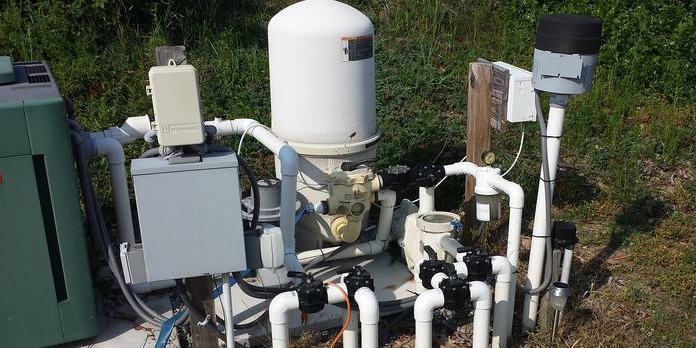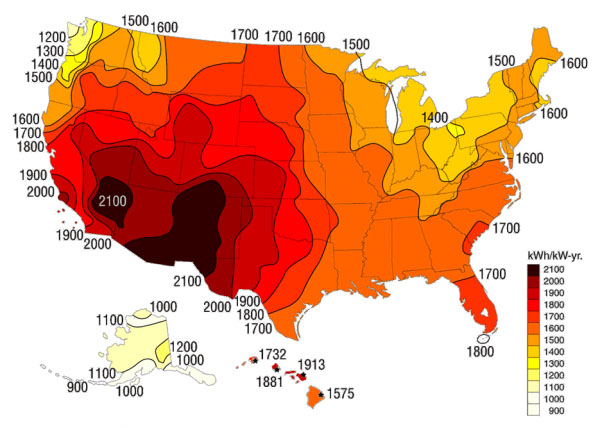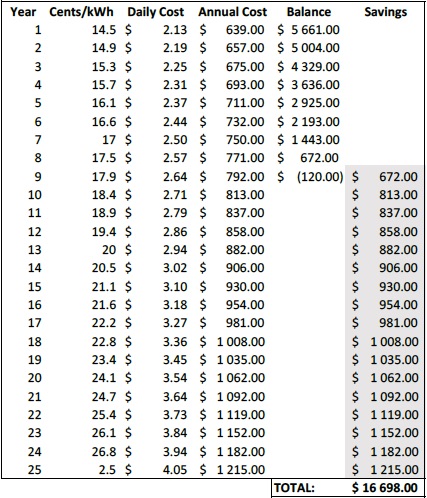Can Money Be Saved by Using Solar Panels for Swimming Pools?

A Realistic Cost Analysis of Running Your Swimming Pool Pump with Solar Panels
If you’re a swimming pool owner or considering becoming one, there’s a good chance you’re concerned about the energy costs involved. It’s also likely that you’re wondering whether solar panels for swimming pools are a viable investment for reducing those costs.
With an average initial installation cost for solar of over $5,000 for a small system (based on 2kW array @ a cost of $3.00/watt, per SEIA data for 2016), there’s reason to wonder. There are a great number of factors to consider, including your location, the power required and the life expectancy of the system, to name just a few. Can you expect to actually realize savings on your electric bill by adding solar power to your pool? Let’s take a look at some real numbers.
Where’s the money going?
The average filter pump for an in-ground pool circulates more water per day than a typical person drinks in a lifetime (based on average 20,000 gal in-ground pool and the recommended 64oz of water daily over 80 years).How much that costs is determined by the amount of power your pump uses per day of operation.
Let’s assume your typical 1HP pump draws 8 amps at 230 volts. To calculate the power required, we multiply the current by the voltage: 8 x 230 = 1,840 watts. Dividing that by 1,000 gives us 1.84 kilowatts (kW), If you run your pump 8 hours each day, that’s 8 x 1.84 = 14.72 kilowatt/hours (kWh) per day.
How much does that cost?
According to the U.S. Energy Information Administration, electricity costs ranged from about 9.5 to about 19.6 cents per kWh in November of 2016. Let’s assume you’re in the mid-range and go with 14.5 cents. That gives us 14.5 x 14.72 = 213.4 cents or $2.13 per day. Not bad. Now, let’s assume that you’re in an area where you can keep your pool open 300 days per year. That’s an annual cost of 2.13 x 300 = $639 per year.
So, if solar panels can generate enough electricity to run that appliance alone, you save more than six hundred bucks a year, right? Maybe, but there’s still the installation cost to consider, so we need to take a look at that.
Let’s do the math
To calculate the cost of installation, you’re first going to need to know how big your solar installation needs to be. We’ve already determined that you need 14.72kWh per day to run the pump and your pump will run 300 days per year. That’s a total of 4,416 kWh annually.
We need a way to determine what size installation in kW you’ll need for that power requirement. Since the actual power output of solar panels depends on where you live, let’s consult the map below:

Map courtesy of National Renewable Energy Laboratory
This handy tool shows us how much power in kWh you can expect to generate per year for each kW your solar array is rated for. Let’s just choose a location that’s sort of in the middle: central Kansas.
The map shows that a 1kW solar system should produce about 1,900kWh per year in this location. So, we divide the total annual requirement by that number: 4,416/1,900 = 2.32kW. Now, there’s just one step left in our calculations; we need to allow for some losses.
Solar panels get dirty, weather conditions affect output and there are losses associated with an inverter and external wiring. Going back to our friends at the National Renewable Energy Laboratory (NERL), we find that, on average, these losses amount to about 24% of the output. To compensate for that, we multiply the 2.32kW by 1.24 and end up with a figure of 2.8768. That means we should probably install a 3kW solar array.
The price of power
Alright, so how much is that solar installation going to cost? The Solar Energy Industries Association reported prices up to $3.00 per watt in 2016. Let’s use the highest cost: 3kW = 3,000 watts x $3.00 = $9,000. That’s a pretty big chunk of change.
Ah, but wait – if you live in the US, there’s a sweet little tax break for installing solar panels! The government will let you deduct 30% of the cost so that 3kW system is only going to cost you about $6,300.
With that number in mind, it’s obvious that you’re not going to realize a return on your investment in the first year. In fact, a little bit of simple math shows that if the installation costs $6,300 and the pump costs $639 a year to run, it will take a little over 10 years for the solar panels to pay for themselves if they’re just running the pump. Does that make this a bad investment? Not really.
Why solar pays
There are two important factors that we haven’t factored in yet: 1) the rising cost of electricity and 2) the lifespan of your solar panels. If you’re paying an electric bill, you already know about the former of those. You may or may not know about the latter.
According to NREL’s Energy Analysis, you’ll find that the average lifespan of solar panels is from 25 to 40 years. Choosing the worst-case scenario means that you can expect at least 15 years of free power for your pool pump if it takes 10 years for the solar installation to pay for itself.
If you’d like to understand how a power source can have such a long life expectancy, take 5 minutes to watch the video below from Ted Education to learn how a solar cell works. (Trust me, it’s not as boring as it sounds.)
Now, where do those rising utility costs figure into this equation? Well, the higher the rate for residential electricity climbs, the more you save by generating your own. To project how much impact the increase will have, we’ll need to establish a rate. Here’s a nice aid from the US Energy Information Administration:

Using the data on the bottom of the chart, you’ll see that the EIA has predicted a 3% increase in rates for 2017 and 2.4% for 2018. We’ll average those and use a figure of 2.7%.
Putting it all together
Now that we’ve got all the data we need, let’s build a projection of our own, to see how much money your solar powered pool pump can potentially save you. We’re using the same scenario as above, with an initial installation cost of $9,000, minus the tax credit, leaving a beginning balance of $6,300 and applying that 2.7% increase every year. We’re also using the same starting rate of 14.5 cents per kWh and 14.72KWh/day.

Given this situation, and applying the annual increase, you’ll actually save enough to pay for the installation early in the 9th year! That turns your savings over the next 15 years into profit. Take a look at the total profit at the end of 25 years. That’s not a bad return, not to mention that you’ll be feeling better about yourself for using a highly renewable, clean source of energy.
It’s important to realize that the actual projected cost of electricity is impossible to predict. Given that we’ve been conservative with all the other numbers, however, the projection makes a very good case for saving money with solar panels.
“What about my state?”
While I regret that I can’t do a projection for every location here, the good news is that the numbers will invariably swing in your favor. Yes, there’s going to be some variance; prices for electricity are nowhere near standardized and some locations are simply more suitable for solar power generation. Check the map above and pricing in your area, then run your own projection.
How many solar panels will I need for my swimming pool?
Determining how many panels you’ll need to operate your pump starts with calculating the power requirement as we did early in this article. Locate the identification plate on your pump and find the current draw in amps. Most pumps will show an 115V rating and a 230V rating, for example, 6A @ 115V.
If your pump is controlled by a single breaker in the panel, use the 115V rating. If it’s connected to a “ganged” breaker with 2 switches, use the 230V rating. Follow the procedure we used to determine the kWh per year needed to run the pump. Then consult the map to determine how many kilowatts your array will need to be rated for.
Once you know how much total power you’ll need, estimating the number of panels is easy. The types of panels on the market today vary widely. Power output from a typical 40” x 65” panel may range from 210W to over 300W, with a corresponding increase in price per panel. Basing your calculations on 250W per panel is a good place to start.
Remember that the total power rating is going to be in thousands of watts (kW). That means that you’ll need four 250-watt panels for each kW. Our 3kW array would require 12 panels of this type.
Conclusion
The short answer to the question of whether solar panels for swimming pools are a good investment is a resounding “Yes.” The length of time to realize the value of the investment depends somewhat on your location, your annual pool usage and the value you place on clean energy. Installing solar power now is a great way to protect yourself from higher billing rates as well as a commitment to lowering your carbon footprint.
To determine your potential savings, you’ll need to take the following steps:
• Determine the power required to drive your filter pump
• Determine the appropriate size of solar array, factoring in your geographical location
• Calculate the cost of installation (Don’t forget that tax deduction!)
• Calculate the projected cost of electricity for the pump over 25 years
• Determine the projected break-over point and your profits
You should find all the information you need for each step in this article. If there’s anything we’ve missed, please fee to ask in the comments.
More:

